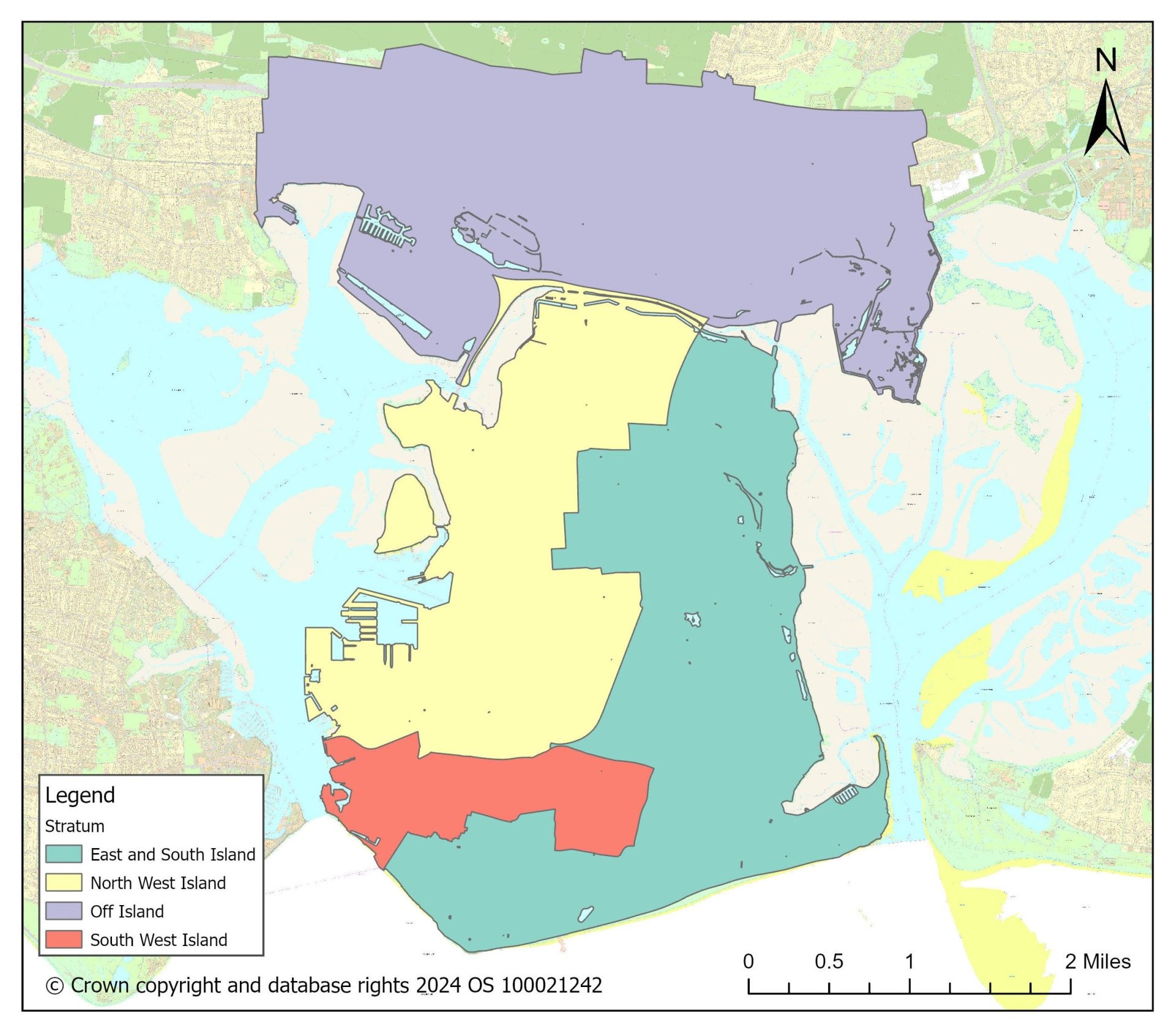Summary
Forest Research have worked with Portsmouth City Council to undertake a study of the city’s tree population using i-Tree Eco.
The study area encompasses the whole of Portsmouth city, covering an area of 3,964 hectares, on and off Portsea Island. Sampling was divided into four areas of the city: East and South Island, South West Island, North West Island, and Off Island. A total of 253 sample plots were distributed within a grid in each area.

In addition, the survey data was divided into land owned by Portsmouth City Council, and other land.

Details of land use, ground cover, shrubs, and trees were recorded in each plot. The i-Tree Eco software was used to extrapolate the data collected in the field to estimate the structure and composition of the whole tree population, and the ecosystem services the trees provide.
This study is the second i-Tree Eco project to include measures of social and cultural values of trees. The Urban Forest and Society and Environment research groups worked together to continue to develop methods that were trialled during the Wirral i-Tree Eco project. This work is part of a wider, Defra-funded project which is part of the Future-Proofing Plant Health programme.
Research Objectives
The aims of this project are:
- To gain a baseline understanding of the distribution and composition of Portsmouth’s tree population
- To undertake a valuation of some of the ecosystem services provided by Portsmouth’s trees
- To gain understanding of the importance of Portsmouth’s trees to local people
Findings and Recommendations
Findings
There are an estimated 111,800 trees in Portsmouth. These trees provide benefits worth £1.7 million per year. To replace the public amenity these trees provide would cost £4.5 billion.
Portsmouth’s tree population is dominated by Acer pseudoplatanus (sycamore) and Fraxinus excelsior (ash). Owing to their large populations, large size, and dense foliage, they are currently the top two species for delivery of many ecosystem services.
Of the trees recorded in the survey, Salix caprea (goat willow) supports the highest number of invertebrate species.
People value trees in Portsmouth for many reasons. Some of the most important include for wildlife, physical and mental health, connection to nature, and aesthetic reasons.
Survey respondents expressed strong willingness to take action for trees in Portsmouth. Four-fifths indicated interest in joining tree related events or campaigns or in joining a community group to care for trees, and 39% of respondents with a garden would consider planting a tree there. There is a community of people who want to help, provided there are the right kinds of opportunities.
Recommendations
Canopy cover
All areas of Portsmouth fall below the 16.5% UK government target for tree canopy cover. Increase planting in areas that are lacking in canopy cover, especially in the South West Island area, to improve benefit provision.
Undertake an assessment of recent trends in canopy cover across Portsmouth, including the causes of change. Where recent trends are for declining cover, greater effort can be focussed to reverse the causes of change. This can help Portsmouth reach its target to double canopy cover to 19.6% over the next 25 years.
Tree diversity
The diversity of Portsmouth’s tree population is lower than ideal with Acer pseudoplatanus and Fraxinus excelsior dominating the overall tree population. Planting a more diverse range of species can offer a long-term higher level of resilience for Portsmouth’s trees from climate change. A more diverse tree population will also be resilient to pests and diseases as there is less potential for large numbers of trees to be affected by an outbreak.
Respondents to the people survey indicated preferences for particular species, including Oak, Birch, Cherry, Plane, Apple, Ash, Rowan, and Beech, but also more broadly for native trees, fruit trees, trees with blossom, and trees beneficial to wildlife.
Structure
The low numbers of trees in the two largest DBH size classes indicate that Portsmouth’s overall tree population is smaller (or younger) than ideal. Large trees provide the greatest quantity of benefits. Retain large, mature trees wherever possible. Aim to make large, mature trees a part of new developments rather than removing and replacing them. The South West Island area is underrepresented for large trees. Providing care and protection to the younger and smaller trees in this area to grow and become large trees will allow them to deliver greater levels of benefit.
Planting
Residential is the largest land use category in Portsmouth. Trees in private gardens and on residential streets are the most common locations of trees visible from respondents’ homes and many respondents said their gardens already have trees, or they would be willing to consider planting a tree. Working with residents to promote the benefits of trees can help protect preexisting trees in these areas and encourage new tree planting in private gardens.
Carbon storage and sequestration
Ensure the survival of existing large trees to maintain the carbon storage and sequestration benefit they currently provide. Plant new trees to replace the ones that will eventually be lost, and to increase canopy cover.
Wide range of benefits
As well as planting trees for carbon storage and sequestration, consider other benefits as well. Salix caprea, supports 450 different species but only represents 1.1% of the Portsmouth tree community. Taking account of factors such as wildlife provision when selecting planting material will improve the overall benefits the trees in Portsmouth provide.

Downloads
Funding & Partners
-
 Portsmouth City Council
Portsmouth City Council -
 Defra
Defra


